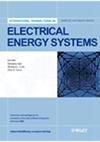S. Ganjefar, Morteza Tofighi
{"title":"基于非平稳惩罚函数的改进遗传算法求解动态经济调度","authors":"S. Ganjefar, Morteza Tofighi","doi":"10.1002/ETEP.520","DOIUrl":null,"url":null,"abstract":"This paper presents an improved genetic algorithm with non-stationary penalty functions (IGA-NSPF) to solve the dynamic economic dispatch (DED) problem of generating units while considering valve-point effects. The cost function of the generating units exhibits the non-convex characteristics, as the valve-point effects are modeled and imposed as rectified sinusoid components in the cost function. An improved evolution direction operator and gene swap operator are introduced in the proposed approach to improve the convergence characteristic of the genetic algorithm (GA). The non-stationary penalty functions (NSPF) are introduced to put more selective pressure on the GA to find a feasible solution, resulting in difficulty during solution searching. The non-stationary penalty is a function of the number of iterations that, in the proposed method, are based on a sigmoid function as the number of iteration increases so does the penalty. To illustrate the effectiveness of the proposed method, a dispatch case consisting of 10 units and 24 time intervals has been considered. Numerical results indicate that the performance of the IGA-NSPF presents the best results when compared with previous optimization methods in solving DED problems with the valve-point effect. Copyright © 2010 John Wiley & Sons, Ltd.","PeriodicalId":50474,"journal":{"name":"European Transactions on Electrical Power","volume":"21 1","pages":"1480-1492"},"PeriodicalIF":0.0000,"publicationDate":"2011-04-01","publicationTypes":"Journal Article","fieldsOfStudy":null,"isOpenAccess":false,"openAccessPdf":"https://sci-hub-pdf.com/10.1002/ETEP.520","citationCount":"28","resultStr":"{\"title\":\"Dynamic economic dispatch solution using an improved genetic algorithm with non‐stationary penalty functions\",\"authors\":\"S. Ganjefar, Morteza Tofighi\",\"doi\":\"10.1002/ETEP.520\",\"DOIUrl\":null,\"url\":null,\"abstract\":\"This paper presents an improved genetic algorithm with non-stationary penalty functions (IGA-NSPF) to solve the dynamic economic dispatch (DED) problem of generating units while considering valve-point effects. The cost function of the generating units exhibits the non-convex characteristics, as the valve-point effects are modeled and imposed as rectified sinusoid components in the cost function. An improved evolution direction operator and gene swap operator are introduced in the proposed approach to improve the convergence characteristic of the genetic algorithm (GA). The non-stationary penalty functions (NSPF) are introduced to put more selective pressure on the GA to find a feasible solution, resulting in difficulty during solution searching. The non-stationary penalty is a function of the number of iterations that, in the proposed method, are based on a sigmoid function as the number of iteration increases so does the penalty. To illustrate the effectiveness of the proposed method, a dispatch case consisting of 10 units and 24 time intervals has been considered. Numerical results indicate that the performance of the IGA-NSPF presents the best results when compared with previous optimization methods in solving DED problems with the valve-point effect. Copyright © 2010 John Wiley & Sons, Ltd.\",\"PeriodicalId\":50474,\"journal\":{\"name\":\"European Transactions on Electrical Power\",\"volume\":\"21 1\",\"pages\":\"1480-1492\"},\"PeriodicalIF\":0.0000,\"publicationDate\":\"2011-04-01\",\"publicationTypes\":\"Journal Article\",\"fieldsOfStudy\":null,\"isOpenAccess\":false,\"openAccessPdf\":\"https://sci-hub-pdf.com/10.1002/ETEP.520\",\"citationCount\":\"28\",\"resultStr\":null,\"platform\":\"Semanticscholar\",\"paperid\":null,\"PeriodicalName\":\"European Transactions on Electrical Power\",\"FirstCategoryId\":\"1085\",\"ListUrlMain\":\"https://doi.org/10.1002/ETEP.520\",\"RegionNum\":0,\"RegionCategory\":null,\"ArticlePicture\":[],\"TitleCN\":null,\"AbstractTextCN\":null,\"PMCID\":null,\"EPubDate\":\"\",\"PubModel\":\"\",\"JCR\":\"\",\"JCRName\":\"\",\"Score\":null,\"Total\":0}","platform":"Semanticscholar","paperid":null,"PeriodicalName":"European Transactions on Electrical Power","FirstCategoryId":"1085","ListUrlMain":"https://doi.org/10.1002/ETEP.520","RegionNum":0,"RegionCategory":null,"ArticlePicture":[],"TitleCN":null,"AbstractTextCN":null,"PMCID":null,"EPubDate":"","PubModel":"","JCR":"","JCRName":"","Score":null,"Total":0}
引用次数: 28
Dynamic economic dispatch solution using an improved genetic algorithm with non‐stationary penalty functions
This paper presents an improved genetic algorithm with non-stationary penalty functions (IGA-NSPF) to solve the dynamic economic dispatch (DED) problem of generating units while considering valve-point effects. The cost function of the generating units exhibits the non-convex characteristics, as the valve-point effects are modeled and imposed as rectified sinusoid components in the cost function. An improved evolution direction operator and gene swap operator are introduced in the proposed approach to improve the convergence characteristic of the genetic algorithm (GA). The non-stationary penalty functions (NSPF) are introduced to put more selective pressure on the GA to find a feasible solution, resulting in difficulty during solution searching. The non-stationary penalty is a function of the number of iterations that, in the proposed method, are based on a sigmoid function as the number of iteration increases so does the penalty. To illustrate the effectiveness of the proposed method, a dispatch case consisting of 10 units and 24 time intervals has been considered. Numerical results indicate that the performance of the IGA-NSPF presents the best results when compared with previous optimization methods in solving DED problems with the valve-point effect. Copyright © 2010 John Wiley & Sons, Ltd.

 求助内容:
求助内容: 应助结果提醒方式:
应助结果提醒方式:


